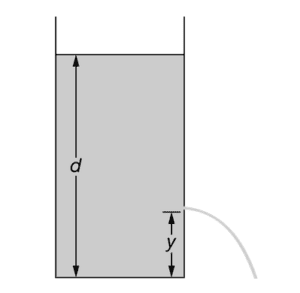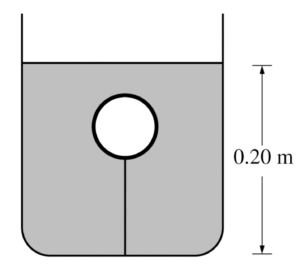0 attempts
0% avg
UBQ Credits
| Step | Derivation/Formula | Reasoning |
|---|---|---|
| 1 | \[ p = \frac{F}{A} \] | Pressure in a hydraulic system is given by the force divided by the area over which the force is applied. |
| 2 | \[ A_{\text{small}} = \frac{\pi d_{\text{small}}^2}{4} \] | The area of a circular piston is found using the formula with the diameter. Here, \(d_{\text{small}} = 3.0\,\text{cm} = 0.03\,\text{m}\). |
| 3 | \[ p = \frac{72}{\frac{\pi (0.03)^2}{4}} \] | This expresses the pressure produced by the \(72\,\text{N}\) applied on the small piston. |
| 4 | \[ A_{\text{big}} = \frac{\pi d_{\text{big}}^2}{4} \quad \text{and} \quad p = \frac{20000}{A_{\text{big}}} \] | The larger piston supports the ride with a force of \(20000\,\text{N}\), and its area relates to its diameter by the same formula. |
| 5 | \[ \frac{72}{\frac{\pi (0.03)^2}{4}} = \frac{20000}{\frac{\pi d_{\text{big}}^2}{4}} \] | Since the pressure is identical throughout the hydraulic fluid, we equate the pressures exerted on both pistons. |
| 6 | \[ \frac{72}{(0.03)^2} = \frac{20000}{d_{\text{big}}^2} \] | The common factor \(\frac{\pi}{4}\) cancels out from both sides. |
| 7 | \[ d_{\text{big}}^2 = \frac{20000 \times (0.03)^2}{72} \] | We isolate \(d_{\text{big}}^2\) by cross-multiplying. |
| 8 | \[ d_{\text{big}}^2 = \frac{20000 \times 0.0009}{72} = \frac{18}{72} = 0.25 \] | Calculating \((0.03)^2 = 0.0009\); then \(20000 \times 0.0009 = 18\) and finally \(\frac{18}{72} = 0.25\). |
| 9 | \[ d_{\text{big}} = \sqrt{0.25} = 0.5 \;\text{m} \] | Taking the square root of both sides provides the diameter of the large piston. |
| 10 | \[ \boxed{0.50\,\text{m}} \] | This is the final answer for the diameter of the piston that holds the ride. |
Just ask: "Help me solve this problem."

In the laboratory, you are given a cylindrical beaker containing a fluid and you are asked to determine the density \( \rho \) of the fluid. You are to use a spring of negligible mass and unknown spring constant \( k \) that is attached to a vertical stand.
A geologist suspects that her rock specimen is hollow, so she weighs the specimen in both air and water. When completely submerged, the rock weighs twice as much in air as it does in water.
A \(2\)-N force is used to push a small piston \(10\) \(\text{cm}\) downward in a simple hydraulic machine. If the opposite large piston rises by \(0.5\) \(\text{cm}\), what is the maximum weight the large piston can lift?

The figure shows a container filled with water to a depth \( d \). The container has a hole a distance \( y \) above its bottom, allowing water to exit with an initially horizontal velocity. Which of the following correctly predicts and explains how the speed of the water as it exits the hole would change if the distance \( y \) above the bottom of the container increased?

A beaker weighing \( 2.0 \) \( \text{N} \) is filled with \( 5.0 \times 10^{-3} \) \( \text{m}^3 \) of water. A rubber ball weighing \( 3.0 \) \( \text{N} \) is held entirely underwater by a massless string attached to the bottom of the beaker, as represented in the figure above. The tension in the string is \( 4.0 \) \( \text{N} \). The water fills the beaker to a depth of \( 0.20 \) \( \text{m} \). Water has a density of \( 1000 \) \( \text{kg/m}^3 \). The effects of atmospheric pressure may be neglected.
\(0.50\,\text{m}\)
By continuing you (1) agree to our Terms of Sale and Terms of Use and (2) consent to sharing your IP and browser information used by this site’s security protocols as outlined in our Privacy Policy.
| Kinematics | Forces |
|---|---|
| \(\Delta x = v_i t + \frac{1}{2} at^2\) | \(F = ma\) |
| \(v = v_i + at\) | \(F_g = \frac{G m_1 m_2}{r^2}\) |
| \(v^2 = v_i^2 + 2a \Delta x\) | \(f = \mu N\) |
| \(\Delta x = \frac{v_i + v}{2} t\) | \(F_s =-kx\) |
| \(v^2 = v_f^2 \,-\, 2a \Delta x\) |
| Circular Motion | Energy |
|---|---|
| \(F_c = \frac{mv^2}{r}\) | \(KE = \frac{1}{2} mv^2\) |
| \(a_c = \frac{v^2}{r}\) | \(PE = mgh\) |
| \(T = 2\pi \sqrt{\frac{r}{g}}\) | \(KE_i + PE_i = KE_f + PE_f\) |
| \(W = Fd \cos\theta\) |
| Momentum | Torque and Rotations |
|---|---|
| \(p = mv\) | \(\tau = r \cdot F \cdot \sin(\theta)\) |
| \(J = \Delta p\) | \(I = \sum mr^2\) |
| \(p_i = p_f\) | \(L = I \cdot \omega\) |
| Simple Harmonic Motion | Fluids |
|---|---|
| \(F = -kx\) | \(P = \frac{F}{A}\) |
| \(T = 2\pi \sqrt{\frac{l}{g}}\) | \(P_{\text{total}} = P_{\text{atm}} + \rho gh\) |
| \(T = 2\pi \sqrt{\frac{m}{k}}\) | \(Q = Av\) |
| \(x(t) = A \cos(\omega t + \phi)\) | \(F_b = \rho V g\) |
| \(a = -\omega^2 x\) | \(A_1v_1 = A_2v_2\) |
| Constant | Description |
|---|---|
| [katex]g[/katex] | Acceleration due to gravity, typically [katex]9.8 , \text{m/s}^2[/katex] on Earth’s surface |
| [katex]G[/katex] | Universal Gravitational Constant, [katex]6.674 \times 10^{-11} , \text{N} \cdot \text{m}^2/\text{kg}^2[/katex] |
| [katex]\mu_k[/katex] and [katex]\mu_s[/katex] | Coefficients of kinetic ([katex]\mu_k[/katex]) and static ([katex]\mu_s[/katex]) friction, dimensionless. Static friction ([katex]\mu_s[/katex]) is usually greater than kinetic friction ([katex]\mu_k[/katex]) as it resists the start of motion. |
| [katex]k[/katex] | Spring constant, in [katex]\text{N/m}[/katex] |
| [katex] M_E = 5.972 \times 10^{24} , \text{kg} [/katex] | Mass of the Earth |
| [katex] M_M = 7.348 \times 10^{22} , \text{kg} [/katex] | Mass of the Moon |
| [katex] M_M = 1.989 \times 10^{30} , \text{kg} [/katex] | Mass of the Sun |
| Variable | SI Unit |
|---|---|
| [katex]s[/katex] (Displacement) | [katex]\text{meters (m)}[/katex] |
| [katex]v[/katex] (Velocity) | [katex]\text{meters per second (m/s)}[/katex] |
| [katex]a[/katex] (Acceleration) | [katex]\text{meters per second squared (m/s}^2\text{)}[/katex] |
| [katex]t[/katex] (Time) | [katex]\text{seconds (s)}[/katex] |
| [katex]m[/katex] (Mass) | [katex]\text{kilograms (kg)}[/katex] |
| Variable | Derived SI Unit |
|---|---|
| [katex]F[/katex] (Force) | [katex]\text{newtons (N)}[/katex] |
| [katex]E[/katex], [katex]PE[/katex], [katex]KE[/katex] (Energy, Potential Energy, Kinetic Energy) | [katex]\text{joules (J)}[/katex] |
| [katex]P[/katex] (Power) | [katex]\text{watts (W)}[/katex] |
| [katex]p[/katex] (Momentum) | [katex]\text{kilogram meters per second (kgm/s)}[/katex] |
| [katex]\omega[/katex] (Angular Velocity) | [katex]\text{radians per second (rad/s)}[/katex] |
| [katex]\tau[/katex] (Torque) | [katex]\text{newton meters (Nm)}[/katex] |
| [katex]I[/katex] (Moment of Inertia) | [katex]\text{kilogram meter squared (kgm}^2\text{)}[/katex] |
| [katex]f[/katex] (Frequency) | [katex]\text{hertz (Hz)}[/katex] |
General Metric Conversion Chart
Example of using unit analysis: Convert 5 kilometers to millimeters.
Start with the given measurement: [katex]\text{5 km}[/katex]
Use the conversion factors for kilometers to meters and meters to millimeters: [katex]\text{5 km} \times \frac{10^3 \, \text{m}}{1 \, \text{km}} \times \frac{10^3 \, \text{mm}}{1 \, \text{m}}[/katex]
Perform the multiplication: [katex]\text{5 km} \times \frac{10^3 \, \text{m}}{1 \, \text{km}} \times \frac{10^3 \, \text{mm}}{1 \, \text{m}} = 5 \times 10^3 \times 10^3 \, \text{mm}[/katex]
Simplify to get the final answer: [katex]\boxed{5 \times 10^6 \, \text{mm}}[/katex]
Prefix | Symbol | Power of Ten | Equivalent |
|---|---|---|---|
Pico- | p | [katex]10^{-12}[/katex] | 0.000000000001 |
Nano- | n | [katex]10^{-9}[/katex] | 0.000000001 |
Micro- | µ | [katex]10^{-6}[/katex] | 0.000001 |
Milli- | m | [katex]10^{-3}[/katex] | 0.001 |
Centi- | c | [katex]10^{-2}[/katex] | 0.01 |
Deci- | d | [katex]10^{-1}[/katex] | 0.1 |
(Base unit) | – | [katex]10^{0}[/katex] | 1 |
Deca- or Deka- | da | [katex]10^{1}[/katex] | 10 |
Hecto- | h | [katex]10^{2}[/katex] | 100 |
Kilo- | k | [katex]10^{3}[/katex] | 1,000 |
Mega- | M | [katex]10^{6}[/katex] | 1,000,000 |
Giga- | G | [katex]10^{9}[/katex] | 1,000,000,000 |
Tera- | T | [katex]10^{12}[/katex] | 1,000,000,000,000 |
The most advanced version of Phy. 50% off, for early supporters. Prices increase soon.
per month
Billed Monthly. Cancel Anytime.
Trial –> Phy Pro
Try our free calculator to see what you need to get a 5 on the upcoming AP Physics 1 exam.
A quick explanation
Credits are used to grade your FRQs and GQs. Pro users get unlimited credits.
Submitting counts as 1 attempt.
Viewing answers or explanations count as a failed attempts.
Phy gives partial credit if needed
MCQs and GQs are are 1 point each. FRQs will state points for each part.
Phy customizes problem explanations based on what you struggle with. Just hit the explanation button to see.
Understand you mistakes quicker.

Phy automatically provides feedback so you can improve your responses.
10 Free Credits To Get You Started

By continuing you agree to nerd-notes.com Terms of Service, Privacy Policy, and our usage of user data.
NEW! PHY instantly solves any question
🔥 Elite Members get up to 30% off Physics Tutoring
🧠 Learning Physics this summer? Try our free course.
🎯 Need exam style practice questions? We’ve got over 2000.